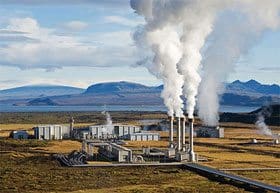Alternative energy sources, especially with regard to air emissions.
The likely life-cycle emissions (taking into account fuel cultivation,
harvesting, collection, transportation and processing, as well as power
plant construction, operation and decommissioning) from main renewable
energy technologies and conventional electricity generation are shown in
Tables 2 and 3.
The results are purely indicative but show the
variations and relative differences between the various fuel inputs.
Life-cycle emissions from renewable energy use are small compared with
those from fossil fuel plants. The studies upon which the figures are
based did not examine nuclear energy.
Though nuclear power
generation does have a major environmental impact, it releases no
sulphur dioxide (SO2) or nitrogen oxides (NOx) and little carbon dioxide
(CO2). Its life cycle emissions of these gases falls within the ranges
shown for non-hydroelectric renewable energy.
Table 2. Life cycle air emissions from renewable energy (g/kWh)
| Energy Crops | Hydro | Hydro | Solar | Solar | Wind | Geothermal | ||
| Current Practice | Future Practice | Small Scale | Large Scale | Photovoltaic | Thermal Electric | |||
| CO2 | 17-27 | 15-18 | 9 | 3.6-11.6 | 98-167 | 26-38 | 7-9 | 79 |
| SO2 | 0.07-0.16 | 0.06-0.08 | 0.03 | 0.009-0.024 | 0.20-0.34 | 0.13-0.27 | 0.02-0.09 | 0.02 |
| NOx | 1.1-2.5 | 0.35-0.51 | 0.07 | 0.003-0.006 | 0.18-0.30 | 0.06-0.13 | 0.02-0.06 | 0.28 |
.
Table 3. Life cycle air emissions from conventional electricity generation in the United Kingdom
Table 3. Life cycle air emissions from conventional electricity generation in the United Kingdom
| Coal | Oil | Gas | Diesel | ||
| Best Practice* | Flue Gas Desulphurisation & Low NOx | Best Practice | Combined Cycle Gas Turbines | Embedded | |
| CO2 | 955.0 | 987.0 | 818.0 | 430.0 | 772.0 |
| SO2 | 11.8 | 1.5 | 14.2 | - | 1.6 |
| NOx | 4.3 | 2.9 | 4.0 | 0.5 | 12.3 |
*
Not representative of state-of-the-art technology. ETSU Report No.
R-88,“Full Fuel Cycle Atmospheric Emissions and Global Warming Impacts
from UK Electricity Generation”, HMSO, London.
Environmental impacts
Renewable
energy entails a number of other potential environmental impacts. On
the negative side, renewable energy can make large tracts of land
unusable for competing uses, disrupt marine life, bird life and
flora/fauna, and produce visual and noise pollution. Generally though,
these potential environmental impacts are site-specific and there are a
number of ways to minimise the effects, which are usually small and
reversible. There are environmental benefits from renewables other than
reduction of greenhouse gas and other air emissions. For example,
hydroelectric schemes can improve water supplies and facilitate
reclamation of degraded land and habitat.
The use of bioenergy can
have many environmental benefits if the resource is produced and used
in a sustainable way. If the land from which bioenergy is produced is
replanted, bioenergy is used sustainably and the carbon released will be
recycled into the next generation of growing plants. The extent to
which bioenergy can displace net emissions of CO2, will depend on the
efficiency with which it can be produced and used. Bioenergy plants have
lower emissions of SO2 than do coal and oil plants, but they may
produce more particulate matter.
These emissions are controllable
but they increase generating costs. The environmental and social effects
of large-scale hydropower are site specific and are the subject of much
controversy. Large-scale projects may disturb local ecosystems, reduce
biological diversity or modify water quality. They may also cause
socio-economic damage by displacing local populations. A number of
projects in developing countries have been stalled or scaled down for
these reasons; obtaining loans from international lending institutions
and banks for major projects has become more difficult. Although these
ill effects can be managed and mitigated to some degree, they may affect
the future of hydropower in general.
Mini- and micro-hydro
systems have relatively modest and localised effects on the environment,
but their kWh cost is generally higher. Hydro-power emits some
greenhouse gases on a life-cycle basis (especially methane generated by
decaying bioenergy in reservoirs), but in most cases far less than the
burning of fossil fuels.

Geothermal plant
Geothermal
plants may release gaseous emissions into the atmosphere during their
operation. These gases are mainly carbon dioxide and hydrogen sulphide
with traces of ammonia, hydrogen, nitrogen, methane, radon, and the
volatile species of boron, arsenic and mercury.
This could slow the
future development of geothermal resources. Emissions can be managed
through strict regulations and by control methods used by the geothermal
industry to meet these regulatory requirements.
Hydrogen sulphide
abatement systems reduce environmental damage but are costly to
install. Wind-power generation has very low emissions on a life cycle
basis, but has a number of environmental effects that may limit its
potential.
The most important effects on the environment
Visual Effects
Wind
turbines must be in exposed areas and are therefore highly visible.
They are considered unsightly by some people, and concerns have
increased with the larger size of new generation turbines.
Noise
Wind
turbines produce aerodynamic noise, from air passing over the blades
and mechanical noise from the moving parts of the turbine, especially
the gearbox. Better designs have reduced noise, and research continues.
Wind farms developed far from highly populated areas are, by definition,
less offensive.
Electromagnetic Interference
Wind
turbines may scatter electromagnetic signals causing interference to
communication systems. Appropriate siting (avoiding military zones or
airports) can minimise this impact.
Bird Safety
Birds get
killed when they collide with the rotating blades of a turbine.
Migratory species are at higher risk than resident species. Siting the
turbines away from migratory routes reduces the impact.
No comments:
Post a Comment